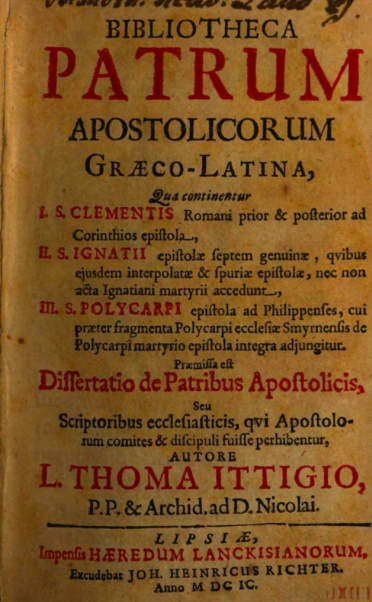While we're on the subject of rare books... another book I needed to hunt down was an 18th century edition of the letters of Saints Clement of Rome, Ignatius of Antioch, and Polycarp of Smyrna, all first and second century Christian bishops.
One of my main characters is something of an armchair theologian. Like most 18th century Bostonians, he's a lifelong Congregationalist, but one with a lot of questions. And he's not one to accept another's say-so with having first examining matters himself.
Such things run in his blood; he's the grandson of a minister. Thankfully, he received a private education that included the study of Latin. In the 18th century, knowing Latin opened intellectual doors: most everything worth reading could be read in Latin.
Following the Reformation, theologians were increasingly interested in the writings of the early Church Fathers, as the differing Christian factions sought to establish themselves against Catholicism. The argument was that the Catholic Church has veered from its apostolic moorings and needed to be purged of its accumulated trappings. (Disclosure: I'm a practicing Catholic.)
Being married to a theologian and patristics scholar, I knew that if my character was going to read the Church Fathers, then I had better find the actual book, double-check its contents, and come up with a plausible account for how my character acquires said book. Not the easiest task! Fortunately, he’s an officer on a merchant ship, and with that comes mobility. When one travels the world, one is more likely to find things that other people wouldn't.
What I found was this:
Bibliotheca Patrum Apostolicorum—Library of the Apostolic Fathers
Once again, hat tip to Google Books.
This edition was edited by a Lutheran divine named Littig, who published the volume in Leipzig in 1699. It includes an opening essay by Professor Littig, followed by the letters of Clement, Ignatius, and Polycarp in both the original Greek and Latin translation on facing pages.
A rare book, indeed! And when my character finds it in a Charleston bookshop owned by a grumpy French ex-pat, he knows that this is the book he wants!
But will he manage to haggle his way to a bargain? When that surly Frenchman knows exactly what kind book he has, beyond a shadow of a doubt?
Good luck, son. Good luck.











